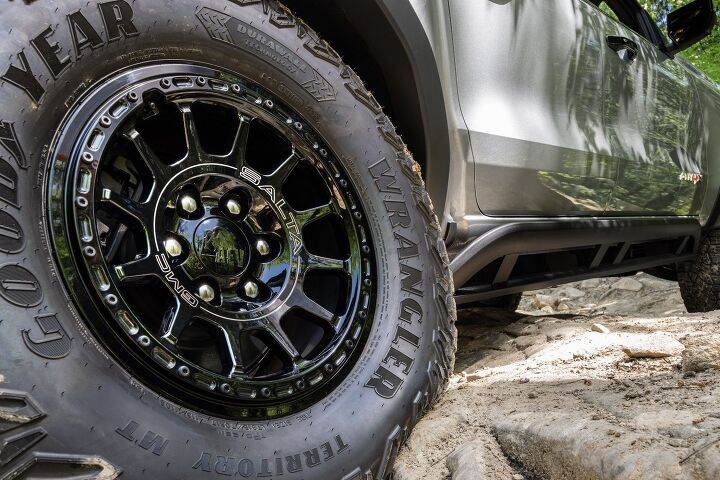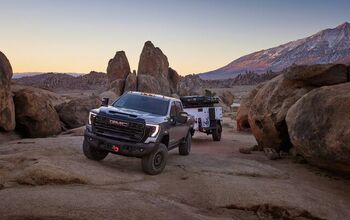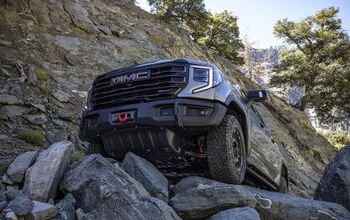GMC Ramps Up Canyon With AT4X AEV Edition

It’s a great time to be fans of burly midsize trucks: the simultaneous existence of Ranger Raptor, Tacoma TRD Pro (plus Trailhunter), and the ZR2/AT4X duo at The General means there is ample choice on the market for shoppers in this segment.
Chevy went one step further by ‘roiding their already ‘roided Colorado ZR2 and creating the ZR2 Bison. Now, GMC dealers get a variant of their own in the new Canyon AT4X AEV Edition.
Building on the AT4X, a rig we’ve sampled in off-road environs and found to be more than capable thanks in no small part to its excellent Multimatic DSSV dampers, the AEV Edition adds a 1.5-inch lift plus 35-inch tires and some extra hardware. In other words, it isn’t just a simple paint and wallpaper job. That 1.5-inch stretch is in addition to the standard AT4X’s 3-inch factory lift, by the way, meaning the AEV has some serious chops when it comes to tiptoeing over the landscape. Off-road angles now check in at 38.2-degree front, 26.9-degree break over, and 26.0-degree departure.
The new 35-inch meats are courtesy of Goodyear, showing up for the party with a set of Wrangler Territory MT rubber. An in-bed spare tire mount is on tap, pushing the narrative that this truck operates solely as a transportation device for its own spare wheel. These tires and that lift conspire to provide over a full foot of ground clearance (12.2 inches, to be exact), a sum very nearly equal to that found on a few pricey dedicated UTV off-roaders.
You’ll have noticed the stamped-steel bumper by now, along with the winch provision upfront. Slung underneath are five skid plates to protect expensive bits, though there’s no mention of the AT4X’s surprisingly useful underbody camera. Let’s hope the new protection doesn’t cover and scupper that feature. They also baked a launch control feature in the truck’s Baja Mode, a detail sure to delight gearheads both on and off the trail. Someone with a clue also added a trio of auxiliary control switches to enable the integration of off-road and overland accessories.
GM’s tie-up with American Expedition Vehicles stems from a conversation they had with AEV boss Dave Harriton, a man who was asked to take a last-gen Colorado ZR2 and equip it with the type of aftermarket gear from which he thought the truck could further benefit. After last year’s redesign, The General continued the relationship which resulted in the truck you see here plus its Chevrolet counterpart.
The 2024 Canyon AT4X AEV Edition is expected to be available for customer orders later this year.
[Images: GMC]
Become a TTAC insider. Get the latest news, features, TTAC takes, and everything else that gets to the truth about cars first by subscribing to our newsletter.

Matthew buys, sells, fixes, & races cars. As a human index of auto & auction knowledge, he is fond of making money and offering loud opinions.
More by Matthew Guy
Latest Car Reviews
Read moreLatest Product Reviews
Read moreRecent Comments
- Dartdude Having the queen of nothing as the head of Dodge is a recipe for disaster. She hasn't done anything with Chrysler for 4 years, May as well fold up Chrysler and Dodge.
- Pau65792686 I think there is a need for more sedans. Some people would rather drive a car over SUV’s or CUV’s. If Honda and Toyota can do it why not American brands. We need more affordable sedans.
- Tassos Obsolete relic is NOT a used car.It might have attracted some buyers in ITS DAY, 1985, 40 years ago, but NOT today, unless you are a damned fool.
- Stan Reither Jr. Part throttle efficiency was mentioned earlier in a postThis type of reciprocating engine opens the door to achieve(slightly) variable stroke which would provide variable mechanical compression ratio adjustments for high vacuum (light load) or boost(power) conditions IMO
- Joe65688619 Keep in mind some of these suppliers are not just supplying parts, but assembled components (easy example is transmissions). But there are far more, and the more they are electronically connected and integrated with rest of the platform the more complex to design, engineer, and manufacture. Most contract manufacturers don't make a lot of money in the design and engineering space because their customers to that. Commodity components can be sourced anywhere, but there are only a handful of contract manufacturers (usually diversified companies that build all kinds of stuff for other brands) can engineer and build the more complex components, especially with electronics. Every single new car I've purchased in the last few years has had some sort of electronic component issue: Infinti (battery drain caused by software bug and poorly grounded wires), Acura (radio hiss, pops, burps, dash and infotainment screens occasionally throw errors and the ignition must be killed to reboot them, voice nav, whether using the car's system or CarPlay can't seem to make up its mind as to which speakers to use and how loud, even using the same app on the same trip - I almost jumped in my seat once), GMC drivetrain EMF causing a whine in the speakers that even when "off" that phased with engine RPM), Nissan (didn't have issues until 120K miles, but occassionally blew fuses for interior components - likely not a manufacturing defect other than a short developed somewhere, but on a high-mileage car that was mechanically sound was too expensive to fix (a lot of trial and error and tracing connections = labor costs). What I suspect will happen is that only the largest commodity suppliers that can really leverage their supply chain will remain, and for the more complex components (think bumper assemblies or the electronics for them supporting all kinds of sensors) will likley consolidate to a handful of manufacturers who may eventually specialize in what they produce. This is part of the reason why seemingly minor crashes cost so much - an auto brand does nst have the parts on hand to replace an integrated sensor , nor the expertice as they never built them, but bought them). And their suppliers, in attempt to cut costs, build them in way that is cheap to manufacture (not necessarily poorly bulit) but difficult to replace without swapping entire assemblies or units).I've love to see an article on repair costs and how those are impacting insurance rates. You almost need gap insurance now because of how quickly cars depreciate yet remain expensive to fix (orders more to originally build, in some cases). No way I would buy a CyberTruck - don't want one, but if I did, this would stop me. And it's not just EVs.




































Comments
Join the conversation
90% will be Street Queens.
ludicrous pricing aside, the bed mounted spare destroys any reason to get this over a wrangler or bronco.